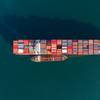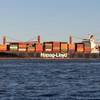NOAA’s Newest Chart to Support Puerto Rico Maritime Economy
The Port of San Juan, which is experiencing a tremendous growth of maritime traffic and planning for more, received an additional economic boost today when NOAA debuted a new nautical chart that will make ocean-going vessel traffic safer and more efficient through San Juan Bay and the port area. “There is not only more traffic, but larger vessels are making San Juan their port call,” said Capt. John Lowell, director of NOAA’s Office of Coast Survey. “NOAA remains committed to providing the navigational products that allow the port to keep up with its level of growth.”
“Mariners asked for NOAA’s help when they started finding themselves too far right of the port entrance,” Lowell said. “The San Juan harbor pilots knew the ship captains were at risk of endangering their vessels. That, and the accompanying risks – groundings, chemical spills, the destruction of endangered coral reefs – was simply too high a price to pay in San Juan Bay.” NOAA maintains and updates the nation’s suite of more than a thousand nautical charts that are used by commercial mariners and recreational boaters to navigate the coastal areas of U.S. waters. NOAA's newest nautical chart covers the approaches to the Port of San Juan. It is the culmination of years of cooperative efforts between NOAA’s Office of Coast Survey, the San Juan Bay Pilots, the Puerto Rico Port Authority, and U.S. Coast Guard Sector San Juan. Currently, all vessels approaching San Juan use NOAA’s 1:100,000 scale chart (North Coast of Puerto Rico), which covers a large portion of the Caribbean Sea north of the Puerto Rican coastline, but provides little detail for entering the harbor. Once inside Bahía de San Juan, NOAA’s 1:10,000 scale chart provides the mariner with specific information for safe navigation. When navigating from the current charts, pilots had trouble going from a chart with scant detail to a harbor chart with magnified details. NOAA’s new chart uses a mid-range scale that allows easier transitioning for navigation.
With NOAA’s new 1:20,000 scale chart (NOAA Chart 25669, Approaches to San Juan), maritime commerce using the Port of San Juan will have the necessary navigational chart transition between the bigger and the smaller charts of the area. Chart 25669 also provides additional detail to ship captains long before making the approach to the entrance at Fort San Felipe del Morro.
During the past 20 years, the Port of San Juan has seen a three-fold increase in the amount of maritime traffic, making San Juan the largest port in the Caribbean region. Puerto Rico exports chemicals, electronics, apparel, canned tuna, rum, beverage concentrates, and medical equipment, and their more than $6 billion of waterborne foreign trade is positioned to expand with planned Panama Canal improvements scheduled for 2014. NOAA formally presented NOAA Chart 25669, “Approaches to San Juan,” to representatives of Puerto Rico's maritime community today at the Sector San Juan (North Coast) Harbor Safety Committee Meeting. To view the chart, visit http://www.charts.noaa.gov/OnLineViewer/25669.shtml.












